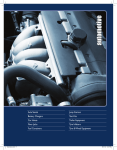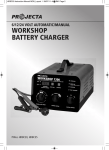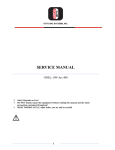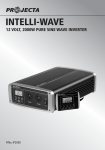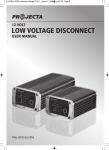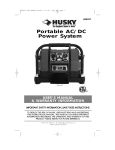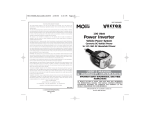Download Projecta HDBC90 Specifications
Transcript
12/24V 70A MANUAL WORKSHOP BATTERY CHARGER P/No. HDBC90 IMPORTANT SAFETY INFORMATION Please read this manual thoroughly before use and store in a safe place for future reference. WARNING • Explosive gases. Prevent flames and sparks. Provide adequate ventilation during charging. • Before charging, read the instructions. • For indoor use. Do not expose to rain. • For charging lead acid batteries ONLY (of the size & voltage specified in the specifications table). • Always charge the battery on the correct voltage setting. Never set the charger to a higher voltage than the battery. • Disconnect the 240V mains supply before making or breaking the connections to the battery. • The battery charger must be plugged into an earthed socket-outlet. • Connection to supply mains is to be in accordance with National wiring rules. • Do not attempt to charge non-rechargeable batteries. • Never charge a frozen battery. • If the AC cord is damaged do not attempt to use. It must be replaced or repaired by a qualified person. • Corrosive substances may escape from the battery during charging and damage delicate surfaces. Store and charge in a suitable area. • Ensure all vehicle accessories including lights, heaters, appliances etc are turned off prior to charging. • This charger is not intended for use by persons (including children) with reduced physical, sensory or mental capabilities, or lack of experience and knowledge, unless they have been given supervision or instruction concerning use of the appliance by a person responsible for their safety. • Young children should be supervised to ensure that they do not play with the appliance. 2 FEATURES ENGINE START FUNCTION Starts vehicle’s with a flat battery after a controlled 5 minute charge. CHARGE METER Clearly displays the rate of charge in Amps to ensure an accurate and thorough charge. ADJUSTABLE OUTPUT Adjust the rate of charge to best suit different battery sizes. RAPID CHARGE Increases charge rate for a short powerful charge. MULTI VOLTAGE OPERATION Suitable for charging 12V & 24V batteries. 0–60MIN TIMER Automatically turns the battery charger off after a set time when charging your battery in Rapid Charge mode. POLARITY PROTECTION Fuse protection prevents damage to the charger in the event of reverse polarity and short circuit. 3 SPECIFICATIONS P/No. TYPE INPUT OUTPUT ENGINE START MINIMUM START VOLTAGE BACK DRAIN APPROVALS 4 HDBC90 Manual 240V, 50Hz, 2000W 9.0A at 12V (setting 1) 23.0A at 12V (setting 2) 60.0A at 12V (setting 3) 70.0A at 12V (rapid charge) 3 sec on, 2 min off 12V24V 360A at 6V 360A at 12V 0.0V 12V24V 5.5mA 11.6mA Electrical Safety, EMC 11.0A at 24V (setting 1) 27.0A at 24V (setting 2) 60.0A at 24V (setting 3) 70.0A at 24V (rapid charge) BATTERY CHARGER ASSEMBLY Your HDBC90 is shipped with the following parts which require assembly to the main body of the battery charger unit: • 1 x Battery Charger Handle • 4 x 50mm Screws • 1 x Bottom Stabiliser Stop • 2 x 50mm Self Tapping Screws • 2 x Trolley Wheels • Wheel Axle • 2 x Black Voltage Terminal Caps • 2 x 35mm Washers • 2 x Wheel Locking Rings. 1. Place the main body of the battery charger in an upright position, install the top handle of the battery charger using the 4 x 50mm screws as per the below illustration. Use a Phillips head screw driver to tighten all 4 screws. 2. Lay the main body of the battery charger down flat and fit the stabiliser stop to the bottom of the battery charger using the 2 x 50mm self tapping screws provided. Use a Phillips head screw driver to tighten screws. 3. Place the wheel axle provided through the bottom of the battery charger as per the below illustration. 4. Place the 2 x 35mm washers on either end of the axle. 5. Fit the 2 trolley wheels to either end of the axle and secure with the 2 x wheel locking ring’s provided. 6. Screw the 2 x black voltage terminal caps provided to both the 12V & 24V outlets on the top panel of the battery charger. 5 ASSEMBLING CHARGING LEADS TO BATTERY CLAMPS The HDBC90 battery charger is shipped with the battery clamps disconnected from the positive & negative charging leads. IMPORTANT: •The negative (Black) battery clamp must be connected to the charging lead connected to the unit. •The positive (Red) battery clamp must be connected to the bare copper end of the second charging lead supplied. Connect the opposite end of the charging lead to either the 12V or 24V outlet on the top panel of the battery charger via the cable lug on the end of the charging lead. To connect both the positive and negative leads to the battery clamps refer to instructions below: 1.Slide the rubber cover off the battery clamp handle. 2.Loosen the bolt located on the outside of the battery clamp handle using a 10mm socket. 3.Feed the bear copper end of the battery clamp lead through the battery clamp handle and position underneath the rectangular nut as per the illustration below. 4.Refit & tighten bolt to create firm connection. 5.Slide the plastic cover back over the battery clamp handle. 6 CHARGING INSTRUCTIONS STEP 1 – CHECK THE ELECTROLYTE LEVEL Prior to charging the battery, remove the vent caps and check the electrolyte level. (Not required on sealed & maintenance free batteries). The electrolyte should be 6mm (1/4”) above the battery’s plates. If low, top up the electrolyte with distilled water to the correct level and refit the vent caps. STEP 2A – CONNECTION OUT OF VEHICLE Connect the RED lead (battery clip) from the charger to the Positive (+) battery post. Connect the BLACK lead (battery clip) from the charger to the Negative (-) battery post. CONNECTION OUT OF VEHICLE POWER ON A 10 WORKSHOP 7000 60 3 FUSE 2 x 100A 50 12/24 VOLT 70 AMP BATTERY CHARGER WITH ENGINE START 20 24V 30 40 12V WORKSHOP 7000 12/24 VOLT 70 AMP BATTERY CHARGER WITH ENGINE START STEP 2B – CONNECTION IN VEHICLE Determine if the vehicle is Positively (+) or Negatively (-) earthed. Negatively earthed vehicles have a cable (usually black) from the Negative battery terminal to the vehicle’s chassis. POWER ON POWER ON 60 10 WORKSHOP 7000 3 A 3 A FUSE 2 x 100A 24V ENGINE START 12/24 VOLT 70 AMP BATTERY CHARGER WITH 40 50 30 WORKSHOP 7000 20 10 12V 60 50 12/24 VOLT 70 AMP BATTERY CHARGER WITH ENGINE START FUSE 2 x 100A 20 24V 30 40 12V NEGATIVELY EARTHED (MOST VEHICLES) WORKSHOP 7000 WORKSHOP 7000 Connect the RED lead (battery clip) from the charger to the Positive (+) battery terminal. 12/24 VOLT 70 AMP BATTERY CHARGER WITH ENGINE START 12/24 VOLT 70 AMP BATTERY CHARGER WITH ENGINE START Connect the BLACK lead (battery clip) from the charger to the vehicle’s chassis away from the fuel line or moving parts. CONNECTION IN VEHICLE (NEGATIVELY EARTHED) POWER ON A WORKSHOP 7000 60 3 FUSE 2 x 100A 10 POWER ON 50 12/24 VOLT 70 AMP BATTERY CHARGER WITH ENGINE START 20 40 60 30 24V 10 WORKSHOP 7000 3 A 12V FUSE 2 x 100A 50 12/24 VOLT 70 AMP BATTERY CHARGER WITH ENGINE START 20 24V 30 40 12V WORKSHOP 7000 12/24 VOLT 70 AMP BATTERY CHARGER WITH ENGINE START WORKSHOP 7000 12/24 VOLT 70 AMP BATTERY CHARGER WITH ENGINE START 7 POWER ON A 10 WORKSHOP 7000 60 3 FUSE 2 x 100A 50 12/24 VOLT 70 AMP BATTERY CHARGER WITH ENGINE START 20 40 24V 30 12V POWER ON A 10 WORKSHOP 7000 60 3 FUSE 2 x 100A 50 12/24 VOLT 70 AMP BATTERY CHARGER WITH ENGINE START 20 24V 30 40 12V POSITIVELY EARTHED Connect the BLACK lead (battery clip)WORKSHOP from 7000 the charger to the Negative (-) battery terminal. 12/24 VOLT 70 AMP BATTERY CHARGER WITH ENGINE START Connect the RED lead (battery clip) from the charger to the vehicle’s chassis away from the fuel line or moving parts. CONNECTION IN VEHICLE (POSITIVELY EARTHED) POWER ON A 10 WORKSHOP 7000 60 3 FUSE 2 x 100A 50 12/24 VOLT 70 AMP BATTERY CHARGER WITH ENGINE START 20 40 24V 30 12V WORKSHOP 7000 12/24 VOLT 70 AMP BATTERY CHARGER WITH ENGINE START STEP 3 – CONNECT TO 240V MAINS POWER Ensure ‘CHARGE RATE’ dial is turned to OFF & connect the battery charger to 240V mains power. STEP 4 – SET BATTERY VOLTAGE Set the voltage of the battery charger by removing the black terminal cap from either the 12V or 24V terminal on the top panel of the jumpstarter. Connect the positive battery cable via the ring terminal to the appropriate 12V or 24V outlet. Ensure the battery charger voltage is set to the same voltage as the battery being charged. STEP 5 – SET THE CHARGE MODE NORMAL CHARGE RATE ADJUSTMENT The normal charge rate can be adjusted by turning the ‘CHARGE RATE’ dial on the top panel of the unit to setting 1, 2 or 3. The charge rate should be set according to the size of the battery. See the recommended charge rates for various battery sizes in the table below: CHARGE RATE BATTERY SIZE Deep Cycle (Ah) Automotive (CCA) Marine (MCA) Time (Hours) Setting 1 (12V) 60–180 380–1080 520–1500 7–24 Setting 1 (24V) 75–220 460–1300 640–1830 7–24 Setting 2 (12V) 160–460 670–2800 1340–3800 7–24 Setting 2 (24V) 190–540 1130–3240 1600–4500 7–24 Setting 3 (12/24V) 420–1200 2500–7200 3500–1000 7–24 8 RAPID CHARGE Turn the ‘CHARGE RATE’ dial on the top panel of the unit to ‘RAPID CHARGE’ & set the timer between 0-60min. The Rapid Charge function will provide a 70A charge to your battery ideal for when a short powerful charge is required. STEP 6 – CHARGING During charging, the Charge Meter’s needle will decrease towards the left. A fully charged battery is indicated by a very low reading according to the battery’s capacity and condition. Once this point has been reached, proceed to disconnect the battery (Refer STEP 7 “DISCONNECTION”). Important: Charging will continue until the On/Off switch is turned to OFF. Charge Meter The battery and charger must be monitored to ensure the battery is not overcharged. Once charged, the liquid inside the battery may start to boil. It is recommended to stop charging when this occurs to prevent damage to the battery. STEP 7 – DISCONNECTION Turn the ‘CHARGE RATE’ dial to the ‘OFF’ position and disconnect charger from the 240V supply. Battery out of vehicle Remove the BLACK lead (battery clip) from the battery. Remove the RED lead (battery clip) from the battery. Battery in vehicle Remove the chassis connection. Remove the battery terminal connection. 9 ENGINE START FUNCTION STEP 1 TO 4 – Follow STEPS 1 to 4 of the charging instructions of this booklet. STEP 5 – Turn the ‘CHARGE RATE’ dial to the ‘RAPID CHARGE’ function, and set the ‘TIMER’ dial to 5 minutes and allow charger to charge the vehicles battery. STEP 6 – Once the 5 minute Rapid Charge is complete, turn the ‘CHARGE RATE’ dial to ‘ENGINE START’. STEP 7 – Turn the vehicle’s ignition key to start the engine. STEP 8 – If engine fails to start after 3 seconds repeat instruction STEP 5 & 6 before attempting to start the engine again. NOTE: Do not repeat this operation more than 5 times. NOTE: When in engine start mode the HDBC90 uses increased power for a short period of time. Ensure other appliances connected to that power circuit are turned off to avoid fuse or circuit breaker overload in the buildings switchboard. 10 PRODUCT OVERVIEW Positive Battery Clamp Negative Battery Clamp Trolley Wheels Bottom Stabiliser Stop 240V Mains Power Cord Charge Meter Power On Indicator Charge/Engine Start/Off Switch Output Fuse Charge Timer 12V/24V Terminals 11 HOW TO CHANGE OUTPUT FUSE The battery charger is fitted with 2 x 100A fuses designed to protect the battery charger against reverse connection & short circuit, the fuse is located on the top panel of the battery charger. To replace blown fuses: 1. Disconnect battery charger from 240V mains power. 2. Disconnect battery charger leads from the vehicles battery. 3. Remove fuse cover on the top panel of the unit. 4. Remove and refit fuses (Projecta P/No. HDBCF100A) using a 10mm socket. 5. Refit fuse cover. 12 FREQUENTLY ASKED QUESTIONS Q.How do I know if the battery is fully charged? A. The Charge Meter’s needle will decrease towards the left. A fully charged battery is indicated by a very low reading. Refer to STEP 6 of the charging instructions for an illustration of the Charge Meter. Alternatively use a Battery Hydrometer (Projecta Part No. BH100). A reading of 1.250 or more in each cell indicates a fully charged battery. Q. Why does the Charge Meter indicate a fully charged battery straight away? A. There are four possible reasons why the Charge Meter may indicate a fully charged battery straight away. 1. The battery is fully charged. 2. The battery has taken a surface charge. 3. The battery has a faulty cell. 4. The BATTERY VOLTAGE setting on the charger is set lower than the battery voltage. Q.What is Surface Charge? A.Batteries unused or left flat for some time build up a resistance to being recharged. When the charger is first connected, these batteries will take a surface charge, and the Charge Meter will indicate a fully charged battery within a short while. The battery however is not fully charged, the charger is voltage sensitive and cannot differentiate between a surface charge and a fully charged battery. After a few hours the battery may start to accept some charge but most batteries with this condition will not recover. Q.What is a Faulty Cell? A.12 Volt batteries contain 6 cells and one faulty cell is enough to ruin your battery. If after eight hours of charging your battery is still flat, you should test the cells using a hydrometer. If one reading is lower than the rest it indicates a faulty cell. It is pointless to continue charging, as the battery needs replacing. Q.Can I use the charger as a power supply? A.No. The HDBC90 cannot be used as a power supply. Do not attempt to connect the clamps to anything other than a suitable battery. 13 Q.What are Volts and Amps? VOLTS The term voltage refers to the electrical force or electric potential to do work between two terminals or a good analogy is water pressure in a pipe. For example a battery has 12 Volts between the positive and negative terminals, or a 6 Volt battery has 6 Volts between the positive and negative terminals. AMPS The term AMPS is the unit of measure used for current. This can be described as the flow of electric charge in a circuit. Again if you use the water analogy this would refer to how much water is flowing through the pipe. For example if the current is reading 12 Amps then this is the amount of energy going into the battery. 14 NOTES: 15 WARRANTY STATEMENT Brown & Watson International Pty Ltd (“BWI”) of 1500 Ferntree Gully Road, Knoxfield, Vic., telephone (03) 9730 6000, fax (03) 9730 6050, warrants that all products described in its current catalogue will under normal use and service be free of failures in material and workmanship for a period of one (1) year from the date of the original purchase by the customer as marked on the invoice. This warranty does not cover ordinary wear and tear, abuse, alteration of products or damage caused by the purchaser. To make a warranty claim the consumer must deliver the product at their cost to the original place of purchase or to any other place which may be nominated by either BWI or the retailer from where the product was bought in order that the warranty assessment may be performed. The consumer must also deliver the original invoice evidencing the date and place of purchase together with an explanation in writing as to the nature of the claim. In the event that the claim is determined to be for a minor failure of the product then BWI reserves the right to repair or replace it at its discretion. In the event that a major failure is determined the consumer will be entitled to a replacement or a refund as well as compensation for any other reasonably foreseeable loss or damage. This warranty is in addition to any other rights or remedies that the consumer may have under State or Federal legislation. IMPORTANT NOTE Our goods come with guarantees that cannot be excluded under the Australian Consumer Law. You are entitled to a replacement or refund for a major failure and compensation for any other reasonably foreseeable loss or damage. You are also entitled to have the goods repaired or replaced if the goods fail to be of acceptable quality and the failure does not amount to a major failure. Distributed by AUSTRALIA Brown & Watson International Pty Ltd Knoxfield, Victoria 3180 Telephone (03) 9730 6000 Facsimile (03) 9730 6050 National Toll Free 1800 113 443 NEW ZEALAND Narva New Zealand Ltd 22–24 Olive Road PO Box 12556 Penrose Auckland, New Zealand Telephone (09) 525 4575 Facsimile (09) 579 1192 IS166 Issue 2 1.6.12
















